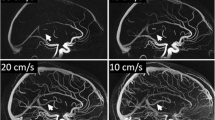Abstract
The first generation of digital subtraction MR angiography using thick-slab contrast-enhanced 2D projection techniques has confirmed the potential of MRI to produce noninvasive subsecond angiograms of the craniocervical circulation. As time-resolved techniques become more sophisticated and 3D acquisitions can be obtained with high isotropic spatial resolution we may start to see the demise of catheter angiography as a diagnostic procedure.





Similar content being viewed by others
References
Marks MP (1995) Vascular malformations. Magn Reson Imaging Clin North Am 3: 485–491
Wilcock DJ, Jaspan T, Worthington BS (1995) Problems and pitfalls of 3-D TOF magnetic resonance angiography of the intracranial circulation. Clin Radiol 50: 526–532
Farb RI, McGregor C, Kim JK et al (2001) Intracranial arteriovenous malformations: real-time auto-triggered elliptic centric-ordered 3D gadolinium-enhanced MR angiography—initial assessment. Radiology 220: 244–251
Wilman AH, Riederer SJ (1997) Performance of an elliptical centric view order for signal enhancement and motion artefact suppression in breath-hold three-dimensional gradient echo imaging. Magn Reson Med 38: 793–802
Korosec FR, Frayne R, Grist TM, Mistretta C (1996) Time-resolved contrast-enhanced 3D MR angiography. Magn Reson Med 36: 345–351
Carroll TJ, Korosec FR, Petermann GM, Grist TM, Turski PA (2001) Carotid bifurcation: evaluation of time-resolved three-dimensional MR angiography. Radiology 220: 525–532
Van Vaals JJ, Brummer ME, Dixon WT, et al (1993) "Keyhole" method for accelerating imaging of contrast uptake. J Magn Reson Imaging 3: 671–675
Doyle M, Walsh EG, Blackwell GG, Pohost G (1995). Block regional interpolation scheme for k-space (BRISK): a rapid cardiac imaging technique. Magn Reson Med 33: 163–170
Riederer SJ, Tasciyan T, Farzaneh F, Lee JN, Wright RC, Herfkens RJ (1988) MR fluoroscopy: technical feasibility. Magn Reson Med 8: 1–15
Mistretta CA, Grist TM, Korosec FR, et al (1998) 3D time-resolved contrast-enhanced MR DSA: advantages and tradeoffs. Magn Reson Med 40: 571–581
Frayne R, Grist TM, Swan JS, Peters DC, Korosec FR, Mistretta CA (2000) 3D MR DSA: effects of injection protocol and image masking. J Magn Reson Imaging 12: 476–487
Peters DC, Korosec FR, Grist TM, et al (2000) Undersampled projection reconstruction applied to MR angiography. Magn Reson Med 43: 91–101
Barger AV, Block WF, Toropov Y, Grist TM, Mistretta CA (2002) Time-resolved contrast-enhanced imaging with isotropic resolution and broad coverage using an undersampled 3D projection trajectory. Magn Reson Med 48: 297–305
Carroll TJ (2002) The emergence of time-resolved contrast-enhanced MR imaging for intracranial angiography. AJNR 23: 346–348
Wang Y, Johnston DL, Breen JF, et al (1996) Dynamic MR digital subtraction angiography using contrast enhancement, fast data acquisition, and complex subtraction. Magn Reson Med 36: 551–556
Hennig J, Scheffler K, Laubenberger J, Strecker R (1997) Time resolved projection angiography after bolus injection of contrast agent. Magn Reson Med 37: 341–345
Strecker R, Scheffler K, Klisch J, et al (2000) Fast functional MRA using time-resolved projection MR-angiography with correlation analysis. Magn Reson Med 43: 303–309
Mori H, Aoki S, Okubo, et al (2003) Two-dimensional thick-slice MR digital subtraction angiography in the assessment of small to medium-size intracranial arteriovenous malformations. Neuroradiology 45: 27–33
Wetzel SG, Bilecen D, Lyrer P, et al (2000) Cerebral dural arteriovenous fistulas: detection by dynamic MR projection angiography. Am J Roentgenol 174: 1293–1295
Griffiths PD, Hoggard N, Warren DJ, Wilkinson ID, Anderson B, Romanowski CA (2000) Brain arteriovenous malformations: assessment with dynamic MR digital subtraction angiography. AJNR 21: 1892–1899
Pruessmann KP, Weiger M, Scheidegger MB, Boesiger P (1999) SENSE: sensitivity encoding for fast MRI. Magn Reson Med 42: 952–962
Golay X, Brown SJ, Itoh R, et al (2001) Time-resolved contrast-enhanced carotid MR angiography using sensitivity encoding (SENSE). AJNR 22: 1615–1619
Aoki S, Yoshikawa T, Hori M, et al (2000) MR digital subtraction angiography for the assessment of cranial arteriovenous malformations and fistulas. Am J Roentgenol 175: 451–453
Tsuchiya K, Katase S, Yoshino A, Hachiya J (2000) MR digital subtraction angiography of cerebral arteriovenous malformations. AJNR 21: 707–711
Warren DJ, Hoggard N, Walton L, et al (2001) Cerebral arteriovenous malformations: comparison of novel magnetic resonance angiographic techniques and conventional catheter angiography. Neurosurgery 48: 973–982
Klisch J, Strecker R, Hennig J, Schumacher (2000) Time-resolved projection MRA: clinical application in intracranial vascular malformations. Neuroradiology 42: 104–107
Coley SC, Romanowski CAJ, Hodgson TJ, Griffiths PD (2002). Dural arteriovenous fistulae: non-invasive diagnosis with dynamic MR digital subtraction angiography. AJNR 23: 404–407
Lasjaunias P, Chiu M, Terbrugge KT, et al (1986) Neurological manifestations of intracranial dural sinus arteriovenous malformations. J Neurosurg 64: 724–730
Aoki S, Yoshikawa T, Hori M, et al (2000) Two-dimensional thick-slice MR digital subtraction angiography for assessment of cerebrovascular occlusive diseases. Eur Radiol 10: 1858–1864
Wetzel SG, Haselhurst R, Bilecen, et al (2001) Preliminary experience with dynamic MR projection angiography in the evaluation of cervico-cranial steno-occlusive disease. Eur Radiol 11: 295–302
Connolly D, Jenkins S, Birchall D, English P, Mandel C (2002) Dynamic subtraction MR venography for the detection of dural sinus thrombosis: a new real-time imaging technique. Neuroradiology 44: 185 (abstract)
Acknowledgements
We wish to acknowledge the expertise of the radiographic staff working in the Academic Section of Radiology, University of Sheffield.
Author information
Authors and Affiliations
Corresponding author
Rights and permissions
About this article
Cite this article
Coley, S.C., Wild, J.M., Wilkinson, I.D. et al. Neurovascular MRI with dynamic contrast-enhanced subtraction angiography. Neuroradiology 45, 843–850 (2003). https://doi.org/10.1007/s00234-003-1075-0
Received:
Accepted:
Published:
Issue Date:
DOI: https://doi.org/10.1007/s00234-003-1075-0




